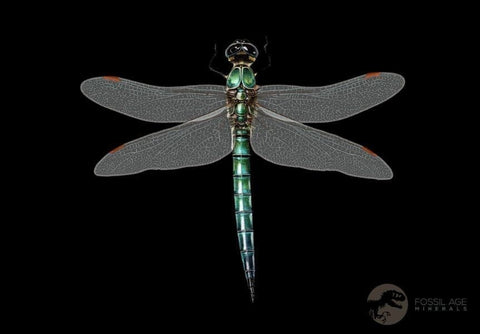0.7" Dragonfly Larvae Fossil Libellula Doris Plate Upper Miocene Piemont Italy Display
Location: Piemonte Area, Santa Vittoria d’Alba. Italy
Weight: 1.7 Ounces With Display.
Dimensions: 3.3 Inches Long, 2.5 Inches Wide, 1 Inch Thick (Display)
Dimensions: 2.1 Inches Long, 1.3 Inches Wide, 0.2 Inches Thick (Plate)
Insect Dimensions: 0.7 Inches Long, 0.5 Inches Wide
Comes with a Free White Display Box.
Comes with a Certificate of Authenticity.
The item pictured is the one you will receive.
Upper Miocene, 16 Million-Year-old
Fossil Dragonfly Larvae, Libellula Doris
Discover the allure of deep time with this captivating Upper Miocene fossil plate featuring three exquisitely preserved dragonfly larvae from Italy's Alpine foothills. Sourced from an exclusive shale quarry, each specimen reveals the intricate morphology that made Libillula skimmers such formidable predators—powerful wings, commanding eyes, and streamlined bodies built for aerial dominance. The masterful arrangement on this thin matrix creates an immediately striking display that commands attention in any collection. These ancient insects represent a lineage stretching back millions of years, their fossil forms offering tangible proof of nature's engineering excellence. Whether you're a seasoned paleontology enthusiast or beginning your fossil journey, this plate delivers both scientific significance and undeniable visual impact—a genuine conversation piece that transforms any space into a window onto prehistoric aquatic worlds.
Female dragonflies lay eggs in or near water, often on floating or emergent plants. When laying eggs, some species will submerge themselves completely to lay their eggs on a suitable surface. The eggs then hatch into naiads. Most of a dragonfly's life is spent in the naiad form, beneath the water's surface, using extendable jaws to catch other invertebrates (often mosquito larvae) or even vertebrates such as tadpoles and fish. They breathe through gills in their rectum, and can rapidly propel themselves by suddenly expelling water through the anus. Some naiads even hunt on land, an aptitude that could have been more common in ancient times, when terrestrial predators were less agile.
The larval stage of large dragonflies can last up to five years, while in smaller species it may range from two months to three years. When the naiad is ready to transform into an adult, it climbs onto a reed or other emergent plant. Exposure to air triggers the process of metamorphosis—the skin splits behind the head, and the adult dragonfly emerges, expanding and drying its wings before taking its first flight. Once airborne, dragonflies are highly agile fliers, capable of moving upward, downward, forward, backward, and even side to side with precision. The adult stage of larger species may last five to six months, during which they feed on smaller insects such as midges and flies.


















